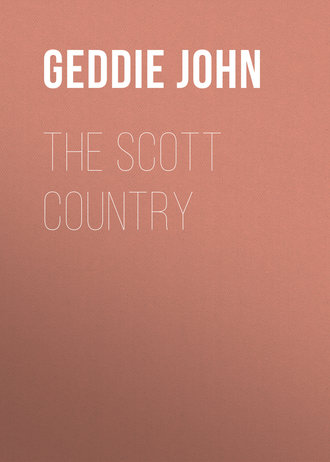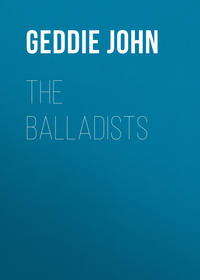 полная версия
полная версияThe Scott Country
A mile out of the town, to the west, is Neidpath Castle, the most commandingly and romantically situated, and, in spite of the yawning gaps made in its walls by Cromwell’s cannon, the best-preserved – Traquair excepted – of the strongholds of the olden time on Tweed. The river is here constricted by the bare cairn-strewn ridge of Caidmuir – once Peebles Common – on the south, and by the Edston heights on the Neidpath side, and has cut a deep ravine through which has drained the great lake that once filled upper Tweeddale. The water swirls around rock and boulder below the castle base; and the screen of trees, whose destruction by that “degenerate Douglas”, Old Q., provoked Wordsworth’s indignant sonnet, has been partially restored. Access to the lofty thick walled double tower, still partly occupied, is by a gateway and courtyard; and over this outer portal are the arms of the early owners – the strawberries of the Frasers of Oliver Castle, from whom are descended the Frasers of the North; and the goat’s head of the Hays of Yester, who here entertained James VI, defied the Commonwealth, and were created Lords of Tweeddale. Afterwards the castle and lands came into the possession of the Douglases of Queensberry, and they now belong to the Earl of Wemyss and March. From the window, now built up, over the arch, as has been sung by Scott and by Campbell, the dying “Maid of Neidpath” looked forth to watch the return of her undiscerning lover. Still discoverable is the casement in the Justice Room of the tower, out of which wrong-doers were hung after summary trial.
As Pennecuik sang two centuries ago:
“The noble Neidpath Peebles overlooksWith its fair bridge and Tweed’s meandering crooks”.But it overlooks much else; and a short distance above it there open up, to right and left, the subsidiary vales of the Lyne and the Manor. The former comes from the “Cauldstaneslap”, in the heart of the Pentlands, and passing on its way, at the meeting with the Tarth, Drochil Castle – built as a retreat by the Regent Morton, who was shortened by a head with a guillotine of his own contriving before he had time to complete his work – enters Tweed below the remains of the great Roman Camp of Lyne. The Manor Water draws its springs from the neighbourhood of Yarrow. Once it was defended by eight strong peels, only one of which, Barns – where Mr. John Buchan has laid the scene of his “John Burnet of Barns” – stands erect. Posso Craigs, where the Stewart Kings bred their falcons, and the sites of St. Gordian’s Kirk and Cross and of “Macbeth’s Castle” can be pointed out. But Manor’s chief memorials are the grave and the cottage of David Ritchie, the prototype of the “Black Dwarf”, the “recluse of Meiklestane Moor”. Scott, as a young visitor to Manor with Adam Ferguson, received an impression which never left him when the deformed and eccentric being, who built his own hut with its doorway three feet high, took him into its arcana, and locking the door and seizing his hand, asked him earnestly: “Hae ye the pooer?” – the power of divination!
The “Thieves’ Road”, by which the Border reivers made their way into Lothian, strikes athwart the hills enclosing the valleys of Manor and Lyne, descending to the Tweed from the slopes of the Scrape to the woods of Dawick. Veitches were succeeded in this sheltered place by Naesmiths, whose fortunes were built up by an indefatigable seventeenth century lawyer known as “the Deil o’ Dawick”. It boasts possession of the oldest larches in Scotland, brought hither on the suggestion of Linnæus, though the honour is disputed by Kailzie lower down Tweed. Across the river is another fine wooded domain – Stobo – whose ancient church preserves a Norman doorway, a saddle-back tower, and a “jougs”; while, from the hills behind, this level strath seems to be menaced by the fragments of Tinnis Castle, set, like a robber tower on the Rhine, on the summit of an almost inaccessible rocky spur. It is believed to have been the original hold of the Tweedies of Drummelzier, a race whose fabled descent was from a Tweed water-nymph, and whose conduct towards their neighbours, the Veitches of Dawick and the Geddeses of Rachan, sadly belied the motto on their tomb at Drummelzier Church – “Thole and Think”. Hard by that edifice at the meeting of the Powsail and the Tweed, and not far from the ruined castle of the Hays of Drummelzier, is another grave of which tradition has much to say – that of “Merlin the Wild”, who prophesied on the spot the Union of the Kingdoms.
Beyond Drummelzier and Broughton, an estate and parish which in the eighteenth century belonged to two historical personages of dubious repute – “Secretary Murray” of the ’45 and M‘Queen of Braxfield, Stevenson’s “Lord Justice Clerk” – the Tweed is found to have dwindled almost to the dimensions of a moorland burn, enclosed among smooth brown “hills of sheep”. Smaller streams pour down in headlong course on either hand; and there are not wanting places of historic and literary note by the river banks and in the tributary valleys. Every burn and haugh has its story of old feuds, in which Frasers and Tweedies, Hunters and Murrays, Scotts and Hays, and other clans of Upper Clydesdale have had a part; and “forts” and “rings” and “chesters” are plentifully sprinkled on the hill-tops. They are especially rife on the heights looking down on the Holms water, which comes from the grassy and heathery folds of Culter Fell and Cardon, and, after joining the Broughton burn, falls into the Tweed below Rachan. For in this neighbourhood, by the “Pass of Corscrine”, ran for a time the frontiers of the Kingdom, as fixed between Edward I and Edward Baliol. Like many other old families of the district, the Geddeses of Rachan, “chiefs of the name”, passed out of the Upper Tweed in poverty and litigation. The like fate, or worse, befell the Murrays of Stanhope, whose representative, after the laird who lost his head in the ’45, was the “Judas” of the Rebellion, for whom Scott’s father showed his contempt, by flinging out of the window the cup from which his caller had partaken of tea in George Square. The fact that they claimed to have received their lands, “for a Bow and a Broad Arrow, when the King comes to hunt in Yarrow”, from Malcolm Canmore did not prevent the Hunters from parting with the estate of Polmood, after one of the longest lawsuits in the annals of even the Scots law.
Stanhope and Polmood have streams tumbling down to Tweed from the heights of Dollar Law and Broad Law, 2800 feet above sea-level; and on the opposite, or right bank, above the fragment of Wrae Castle, which once belonged to the Tweedies, is the site of “Lincumdoddie”, where dwelt “Willie Wastle’s wife”, whose face, according to Burns’s song, “wad fyle the Logan Water”, which runs by it. Beyond the Kinkledoors burn is the “Crook Inn”, beloved by the many anglers who have sought sport and recreation in this solitude among the hills, where, besides Tweed itself, there are many wild side streams – Hearthstane, Menzion, Fruid, and Fingland; Glencraigie, Glenbreck, and Glencor – frequented by brown and yellow trout. But, chief of all, there is the Talla, which, from its springs in lonely Gameshope, rushes down the rocks at Talla Linnfoot, and rests in the two-mile-long reservoir of the Edinburgh Water Company, before joining the Tweed at Tweedsmuir Church, nearly opposite the scant remains of Oliver Castle, where the Frasers first planted themselves on Tweedside.
The Frasers had fled the scene long before the Hunters and the Hays, the Geddeses and the Tweedies, and other families have succeeded and followed them in their flight. Few, and set far apart, are houses and “bields” of any kind, on the lonely road that keeps high up the hillside above the valley floor, until, at “Tweed’s Well”, passing over into Annandale, it parts company with the “Scott Country”.
1
“Penmanscore” is the correct reading, though “Permanscore” is given in the Minstrelsy.




